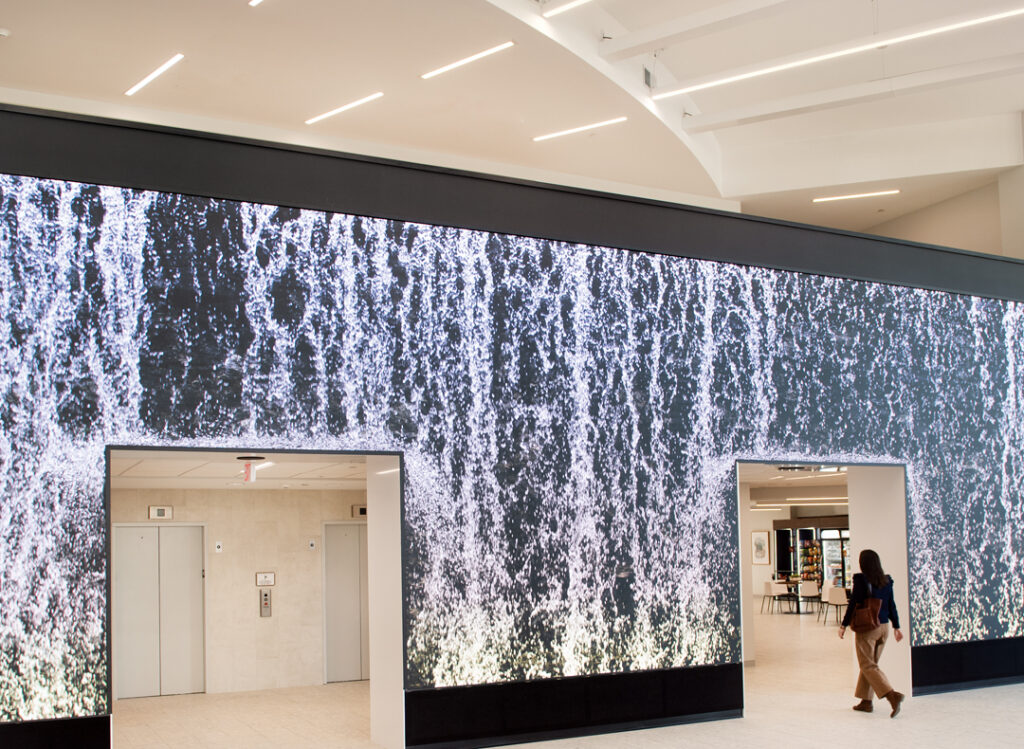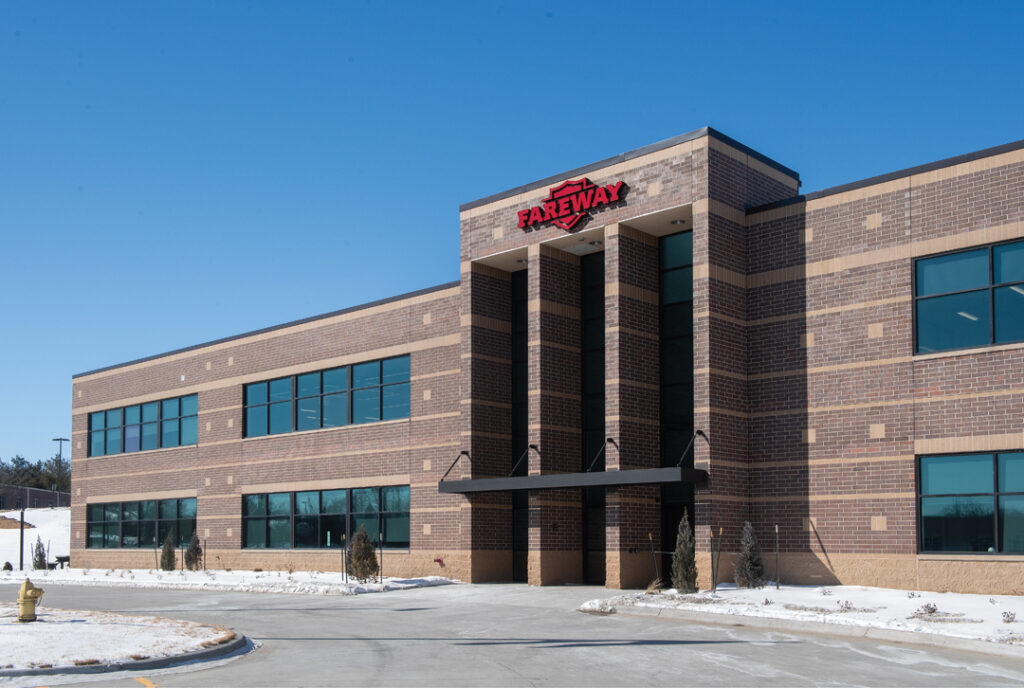Cities turn to town centers as destinations for gathering

Michael Crumb Apr 24, 2025 | 6:00 am
12 min read time
2,970 wordsBusiness Record Insider, Real Estate and DevelopmentAs the District at Prairie Trail in Ankeny approaches its 20th anniversary, other Central Iowa communities are developing their own town-center-style districts to meet the growing demand for places where communities can gather.
Grimes, Waukee and Bondurant are among those with plans — at various stages of development — to build multiuse districts that can create a sense of place for shopping, entertainment and living.

Across the country, town center districts have become desirable developments to repurpose existing neighborhoods or to build new, particularly in communities that don’t have a traditional downtown district, said Caroline Harrelson, strategy director for consulting firm the Retail Coach, which has offices in Dallas and Austin, Texas, and in Tupelo, Miss.
“I think communities that don’t have traditional downtowns, if there is an opportunity for a development like that, it is huge,” she said. “It just revitalizes the community. It reinvigorates the community. It brings a fresh face and all the things. Since COVID especially, people want to be somewhere where they can get out, get fresh air and feel like they’re doing something social, where there’s an entertainment component to it, too.”
She said town centers also provide a good mix of reasons to stay for several hours, including retail, restaurants, coffee shops and entertainment, such as a movie theater or pickleball courts.
“If they’re done right, it’s having that residential component that can help support the retail that’s there,” Harrelson said. “It seems vibrant. It seems alive at all times.”
Too often traditional downtowns are lacking that feeling, especially after 5 p.m., she said.
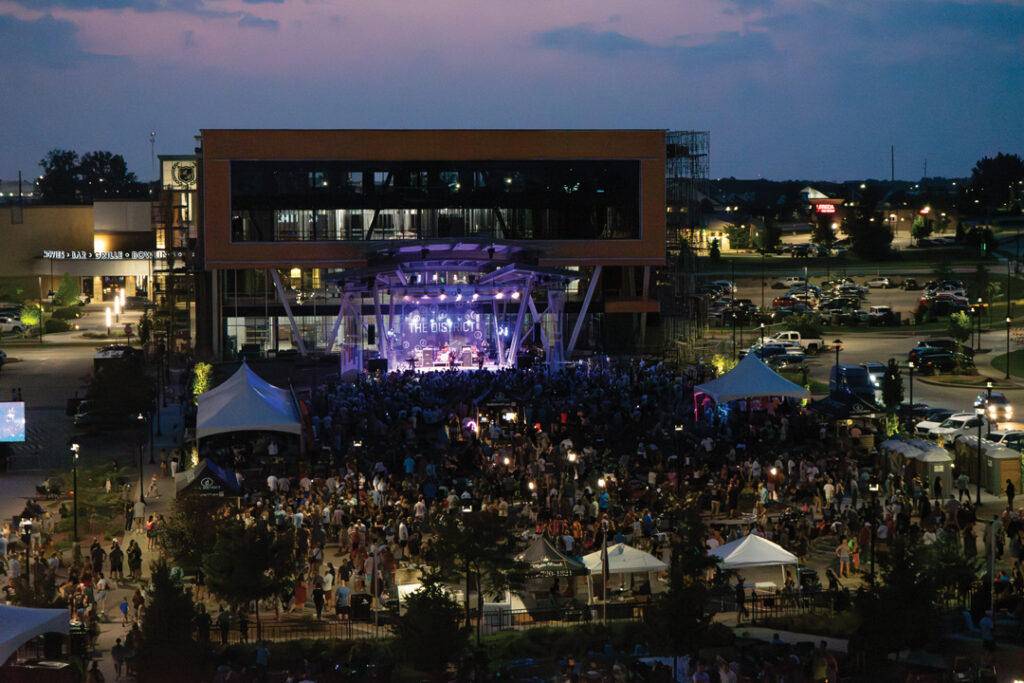
The District at Prairie Trail
The District — and its adjacent neighborhood known as Prairie Trail — began in 2007. It weathered the economic downturn of the late 2000s, the crash of the housing market and the Great Recession, and today more than 75 businesses call the District home.
More than 4,200 people live in Prairie Trail, and that combination of residential and commercial development has created a vibrant, “new urbanism” neighborhood that attracts people. New urbanism is a planning concept that focuses on walkability, housing and shopping in close proximity and accessible public spaces, according to the Congress for New Urbanism.
The District had 2.4 million unique visits over the past year, with visitors spending on average more than two hours there, according to the retail tracking tool Placer.ai.
The District, which sits on about 60 acres, is the commercial hub designed around a town square concept. Everything surrounding that, from Northwest Irvinedale Drive to North Ankeny Boulevard, is what is referred to as Prairie Trail. In all, there are 1,100 acres split by Southwest State Street.
That includes 13 miles of walking trails, 200 acres of parks, and elementary, middle and high schools. There also are senior living, independent and assisted living, dementia care facilities and three hotels.
Anthony Mills, CEO of Apex Sway, the marketing firm for the District, said it’s all about the vision — and the execution of that vision — that has led to the success of the District.
“It’s everything we have here, from professional services to retail, entertainment. We have hotels, dining, health and fitness, and family-friendly activities,” he said. “It’s that vision of bringing the community together and not only the variety of tenants we’ve brought together over the years, but then activating that space.”
He said it’s also become a popular place for office space because of the amenities that are within easy walking distance in the District.
Finding balance
Harrelson said the mix of amenities helps make a town center successful. But she warned that each community must work to make their development unique.
“It’s not as much proximity you have to worry about, it’s the retailers you want to see or the users you want to see,” she said. “If they’re national retailers or users, then that’s going to cannibalize the market. If one in a town over has Kendra Scott or a LuluLemon, don’t go in with the anticipation that you’re going to be able to get those same retailers. There are retailers in those same categories you could get or do local retailers as well as regional. Just be realistic about what retailers would be a good fit for your community.
“I think [that variety] makes it more attractive and what makes yours unique just helps create a destination driver.”
A town center development can be successful just about anywhere, Harrelson said.
“I think they are appropriate in every community,” she said. “Sometimes they’re done on a much larger scale. Sometimes they’re done on a much smaller scale. I think they can be successful in every single community, even those that have a more traditional downtown.”
She used downtown Dallas as an example. Downtown Dallas is a client of Retail Coach and has developed town center districts around its downtown.
“If you look at downtown Dallas, everything is brown, there’s not a great retail synergy or anything there,” she said. “You have this great, sprawling downtown with thousands of daytime office employees with some little districts with residential numbers, but you also have actual and the perceptions of increased crime.
“So Dallas, Texas, with its huge, huge downtown, has these town centers that have popped up in all of the districts surrounding downtown because there’s such a need for that type of development. It’s just what consumers want today. We want somewhere where there’s a sense of community. … I think town centers are appropriate in communities large and small because people just want that sense of connection now.”
She said retail has become more “experiential” than before, and that carries over to town centers “because they have the entire experience.”
“They have the landscaping. They have walkability. They have the neighborhood. They have the neighborhood type stores that you want to see and then some of those local, regional or national users that make the perfect mix,” Harrelson said.
There are challenges for communities weighing a town center development, she said.
“The economics are really, really difficult,” Harrelson said. “Any ground-up deal is really hard right now. Everyone wants second-generation space or something they can just easily rehab. The economy ebbs and flows, but it takes the right developer with the right capital to do a ground-up town center, and finding the right land opportunity.
“You need to have green space. You have to have space for parking. Aligning a city’s vision with what a development can be can ultimately turn out to be tough.”
A local view
Grimes’ Hope District. Waukee’s Town Center. Bondurant’s Grain District Downtown Redevelopment Plan. All are examples of Central Iowa communities’ efforts to create a unique sense of place within their communities.
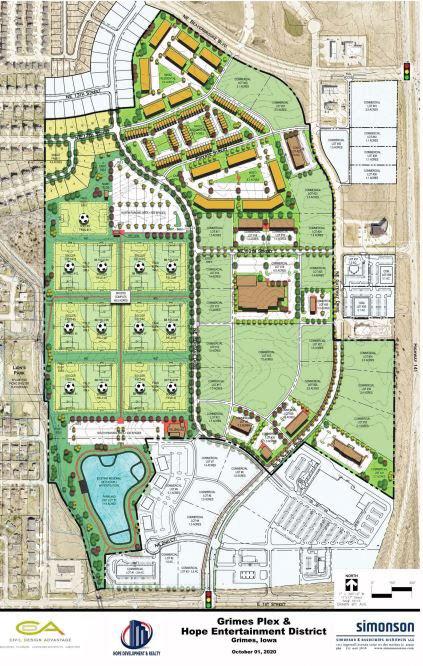
Hope District
Grimes’ Hope District is a 200-acre mixed-use commercial development that is anchored by the Hy-Vee Multiplex, which is 50 acres of fields for youth sports. There is another 80 acres for commercial development, the latest of which are a Chipotle restaurant and a Caribou Coffee, which opened in February. A Tru Hotel by Hilton is also under construction, with an anticipated opening date in September.
A 400-unit apartment and townhome development is also under construction with some units scheduled to open this year.
Katie Lord, the city’s economic development director, said the Hope District will provide urban amenities in a suburban setting, providing a concentration of amenities within a walkable distance for not only residents but also visitors, including the more than 500,000 people who visit the sports complex for various tournaments.
Whitney Tucker, the city’s marketing and communications director, said the district will help make the city a destination for those who come to town for those tournaments.
“We want them to be able to stay at a hotel in Grimes, eat in Grimes, have some sort of entertainment in Grimes, rather than having to go out of town for one of those amenities,” she said.

Lord said Grimes’ Governors District was the original downtown for the city, and while the city is working to ensure it is vibrant and strong, “we have to continue to build in a way that supports our growing population.”
“I think it’s valid that communities have more than one town center,” she said. “I think there’s a benefit in that because they each can serve different segments of the market and the population.”
Lord said the Hope District’s proximity to large, national retailers and Iowa Highway 141 helps make it an attractive destination.
“I think we are uniquely situated to not only develop a strong, local asset for residents, but it’s something that will be attractive to many businesses in the marketplace,” she said.
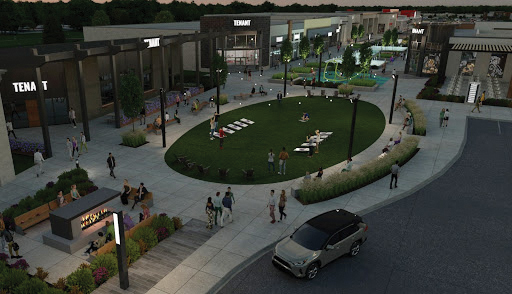
Waukee Town Center
Waukee’s development is 62 acres, anchored by a new Target store that opened in October 2024. In addition to creating a retail hub within the community, the Waukee Town Center will include a 9-acre pond and trail system that will provide a park-like setting for visitors and adjacent residents, said Jennifer Brown, the city’s director of economic development.
It will also include an ice skating rink and amphitheater.
Recent additions to the Waukee Town Center include a new Chase Bank branch and Freddy’s Frozen Custard. A site plan has also been approved for an Olive Garden restaurant.

Brown said a market study showed there was a “good bit of leakage” from Waukee when it came to retail, particularly the apparel sector, so developing a town center district is an effort to stop that flow of people leaving Waukee to shop in other areas of the metro.
“There was an opportunity for us, and you have that information that shows we can certainly do some work to recruit and attract a store like Target,” she said. “We knew this wasn’t going to be just bringing in Target. We knew this would be an opportunity for us as more than just one place to shop.”
“Part of the lifestyle center is to wrap it all in one and make an opportunity for our residents to gather, to have a place to eat, have a place to shop, but also bring it all together and have the outdoor recreation and have that lifestyle all in one. That was part of the vision with that 62-acre development.”
The goal is to create that destination for people, Brown said.
“The incentives for that development were specifically to make it about the experience and not just shopping,” she said. “We want to make sure that we build something that draws people to this development that creates a positive and memorable experience for residents and visitors alike.”
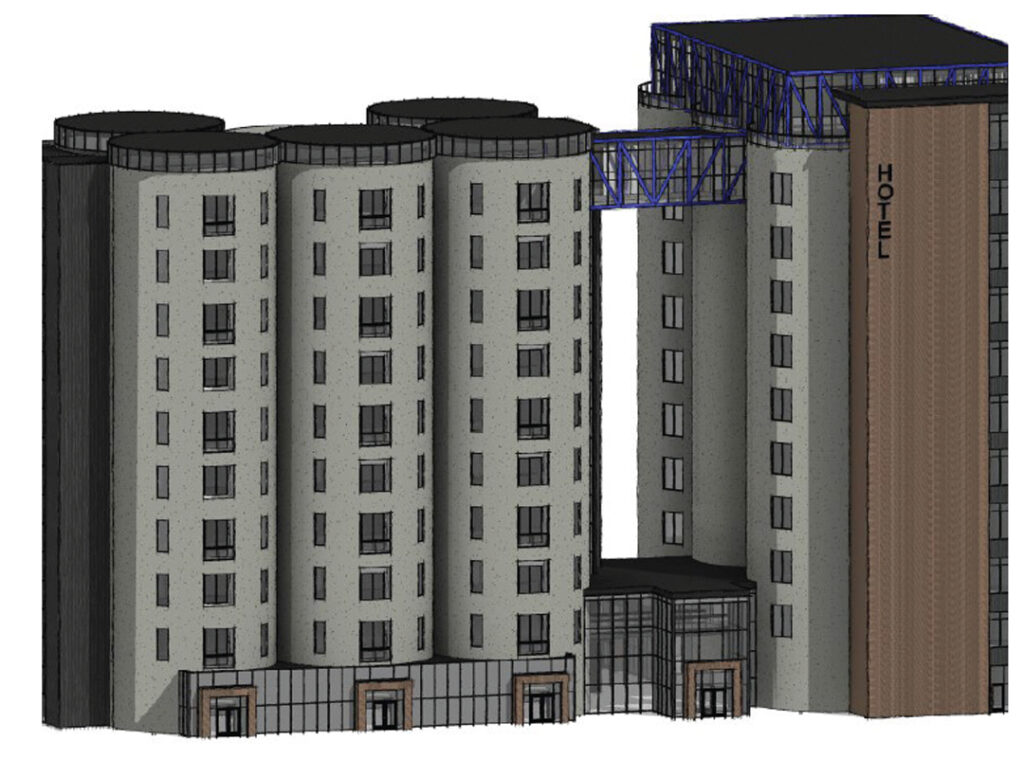
Grain District
Bondurant is undertaking what is likely the most unusual redevelopment opportunity in the metro: its Grain District Downtown Redevelopment Plan.
At the center of the plan is the redevelopment of the former Landus Cooperative grain elevators into commercial and residential space, a hotel, and event space. The plan also includes the redevelopment of the 24-acre site into a commercial district that would include space for retail and restaurants, an area to build townhomes, and public gathering space.
There are also plans for an amphitheater and the transformation of the city’s fire station into space for recreational programs and civic use once the fire department moves to its new location.
The city is working on public infrastructure improvements, including street, parking and improvements on the Chichaqua trail that goes through the area. The city also received a $50,000 grant from Bravo of Greater Des Moines for a public art sculpture in the district.

Besides being an extension of Bondurant’s downtown, the Grain District plan is designed to pay homage to the community’s agriculture history, said Marketa Oliver, the city’s administrator.
“We wanted to embrace our agricultural history because the co-op and the silos have been the heart of the community and the community grew up around it,” she said. “We wanted to figure out how we can create something special that uses those features and transforms them, as opposed to just tearing them down.”
Despite the unique nature of the plan, Oliver said the catalyst behind the vision is similar to that of other communities: “To create that sense of place that becomes a destination for people to gather for a variety of purposes.”
The first commercial development will be a distillery developed by Scott Turczynski, managing partner of the 101 LLC, which is partnering with the city on the project.

Tiffany Luing, the city’s economic development coordinator, said the Grain District project is helping to “reinvent our downtown and bring something that’s creative and different from most places.”
“We have over 9,000 people and our downtown is tiny. It’s unique. It’s quaint and it’s cute, but this development gives us the opportunity to repurpose 24 acres in our downtown and you get to start with a blank slate, other than the silos, which is a great starting point,” she said. “Once you reinvent those silos you have a cute little trail down the middle, street extensions that are vitally needed and then adding those commercial developments. There are a lot of unique little things I have never seen in any other downtown so it’s exciting to build off of that.”
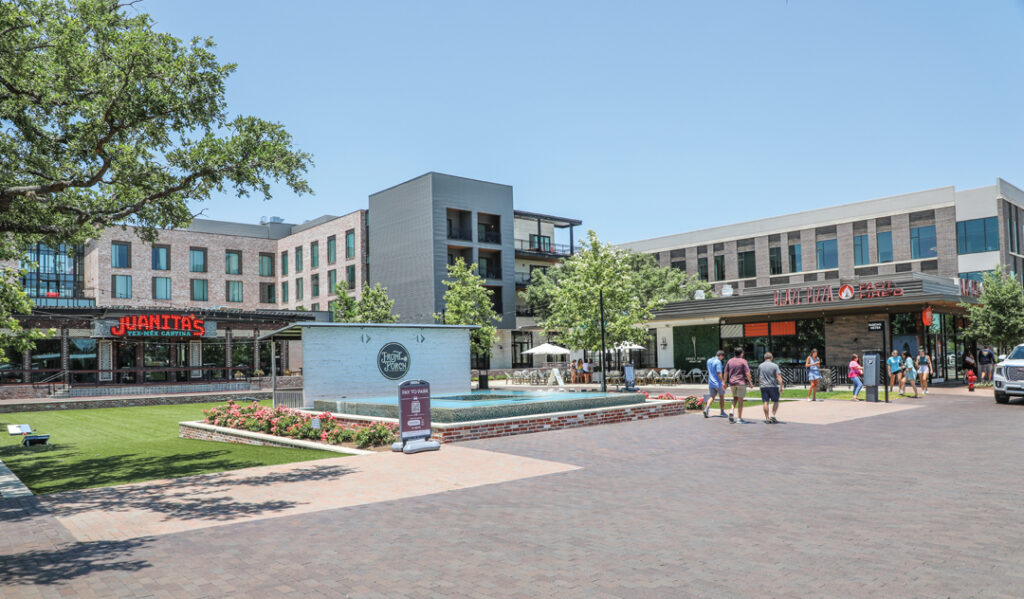
Century Square in College Station, Texas, has become a entertainment and retail hub for the community, which grew around Texas A&M University and lacked a traditional downtown area. Photo provided by the city of College Station
What’s happening elsewhere?
College Station, Texas, is probably best known for being home to Texas A&M University, which was founded in the 1870s. The town grew around the university and it wasn’t until 1938 that College Station was incorporated as a city.
Today, College Station’s population is about 130,000, with more than 70,000 being students.

Brian Piscacek, assistant director of development for the city of College Station, said despite the city’s rapid growth it has lacked a traditional downtown area, so it tried to create that with a town center district called Century Square, which Piscacek described as “our signature entertainment district.”
It’s along the city’s University Drive, a main artery through the community in an area that was originally graduate student housing, across the street from the campus.
“It’s a good example of a public-private partnership with the university,” Piscacek said. “It’s a key entertainment district. It offers two hotels, office uses, diverse retail and restaurants and about 250 multifamily units.”
There’s also green space for outdoor events, such as yoga, a Coffee & Cars car show, and a stage for concerts, he said.
“It’s great because not only does it offer higher-end retail and really unique restaurant experiences, but it’s a place where anybody in the community can gather,” Piscacek said.
Construction of phase one of Century Square began in 2017, with work on phase two beginning in 2023. In all, it encompasses about 60 acres, he said.
Century Square has more than 40 tenants and drew more than 760,000 unique visitors in the past 12 months, with 3.1 million visits. Visitors spend on average more than two hours at Century Square, according to Placer.ai, the retail tracking tool.
Piscacek said building that place for the community to gather was critical not only for people who call College Station home, but also for the city’s efforts to recruit leisure tourists.
“It offers everything you need as an entertainment district,” he said. “It holistically offers a full day experience. You can go to breakfast, do some outdoor activities, catch a movie, have dinner and stay at a hotel that’s on site. It’s such a great pitch for meetings and conventions.”
Town centers are critical for a community to create a sense of place, Piscacek said.
“There are a lot of towns with typical commercial strip retail centers or residential areas and you don’t necessarily feel like you know where you are. It could be anywhere [in the U.S.],” he said. “And Century Square has done a really good job of that through the architectural style and landscaping, that indoor-outdoor presence, the green space, all that contributes to that sense of place to where you know where you are.”
He said it’s important that cities looking at developing a town center district leverage their assets and determine what will make it different and unique from those in other communities. Finding a partner can also be critical, Piscacek said.
“We’re fortunate that we’re a company town. Our company just happens to be a world-class university that has provided insulation from the winds of economic ups and downs and provided steady growth,” he said. “With the university seeking better activation of certain sites, we’ve been able to partner with them on various projects to provide new life into university spaces.”
Creating sense of place
Whether it’s College Station or a community in Central Iowa, developing a district that provides opportunities for community gatherings and a destination for visitors has become a critical component of their economic development plan.
“It is really important to distinguish yourself, and we want to convey that feeling through purposeful placemaking, which is what we’re doing,” said Bondurant’s Oliver. “[The Grain District project] is very unique because a lot of times you’ll find other places where they have to create a distinct center in the heart of the community. We’re just reinvigorating it.”
Lord, Grimes’ economic development director, said the town center concept is the “21st-century version of a historic downtown.”
“So we’re building what we can to meet the needs of our growing resident and visitor population, and having a town center like this is not a would-like-to-have, it’s really a must-have for communities to continue to support their residents, to attract visitors and make sure those dollars stay locally,” she said.

Michael Crumb
Michael Crumb is a senior staff writer at Business Record. He covers real estate and development and transportation.








